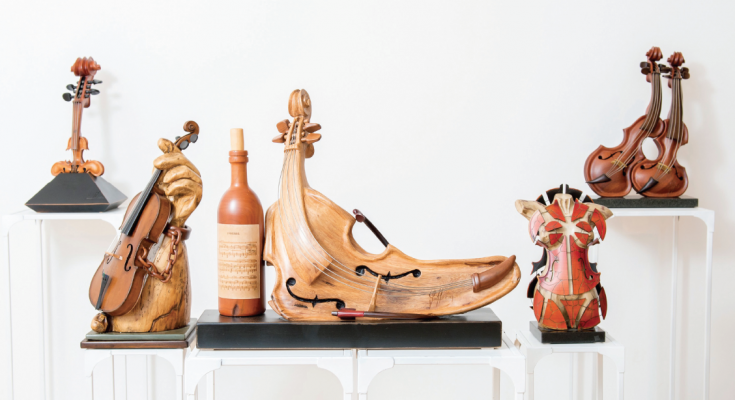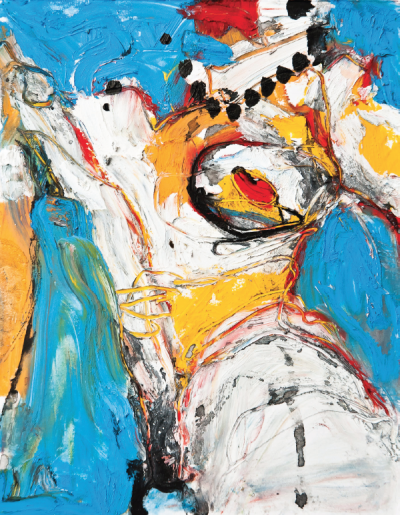Flying Solo: Self-Curating Artists

Sculptures by Philippe Guillerm. Photo: Reid & Evan Sikes, courtesy of the artist.
Freedom, space, posterity. For artists lacking personal wealth, celebrity or patronage, sculptor Donald Judd’s 1981 Chinati Foundation, a permanent installation of his work and vision housed on a decommissioned army base in Marfa, TX, is but a mirage on the murky horizon. Yet take a tour of New England’s artist-run, DIY galleries and you’ll find a thriving scene of scaled-down models where artists can still set their own narrative (and prices).
For French sculptor Philippe Guillerm, gallery ownership came with the purchase and restoration of his house in the coastal town of Waldoboro, ME. With living quarters above, the Philippe Guillerm Gallery opens every April through October, showcasing his latest whimsical sculptures: compositions of driftwood and musical instruments. (The Guillerm family spends the remaining year on their sailboat in the Caribbean, sourcing his materials.)
By day, Guillerm works in the adjoining studio, while his wife, Jacqueline, tends to the steady stream of visitors—tourists, friends, collectors. Having spent upwards of 30 years directing sales of her husband’s work from their boat, she views the gallery as something of a respite; with ample space for storage and display, it’s also an opportunity to share other passions—sailing adventures, among them. “It turns out [the gallery] is a great excuse to meet our neighbors,” she says. Plus, you come to know your buyers first-hand, and foster those relationships over time.
After 19 years selling his work to tourists from around the world, artist and Kennebunkport, ME, gallerist Brad Maushart feels ready to set sail himself: “I’m 65. I want to see a little of the world.” His F-8 Gallery—a nod to his first life as a commercial photographer—is in a 200-year-old barn downtown. A passageway connects to his house; an upstairs level grants studio and framing space. Abstract nudes, painted during Friday morning group sessions at a nearby studio, are displayed alongside stock photographs from his extensive archive.
Brad Maushart, West Side, 2017, oil stick and ink on bristol paper, 5 x 7″. Courtesy of the artist.
Maushart finds Canadians, New Yorkers and Europeans most receptive to the paintings, joking that some visitors find his gallery a little prurient for their tastes. Still he persists, refusing to kowtow to the seascape and tide pool crowd: “I just do my thing.” He enjoys talking about his work (a necessity for any would-be artist/gallerist), cracking jokes and socializing with passersby: “Hey, do you guys want a card?”
F-8 has, he says, sustained his low-key lifestyle—to a point. He opens every day from May through December, with a motion sensor that rings in the house when he happens to be doing the dishes or spending time with his family. Yet, he observes, there’s little left for excess. He runs the show and the show must go on—except on Friday mornings when he has a helper. (Interestingly, Maushart’s daughter runs M Fine Arts Galerie in Boston. She does not, however, represent her father.) When asked what will happen to F-8 if he travels farther afield, Maushart pauses: “The gallery will go on. In some form or other. As long as I’m kicking, the gallery will continue.”
In North Adams, MA, artist Eric Rudd has his sights set on the afterlife. In its fifth season, his Berkshire Art Museum (not to be confused with the Berkshire Museum) boasts five decades of his work on permanent display, as well as that of visiting artists, which Rudd shows in rotating series. Maker, curator and property developer, Rudd, in addition to his museum, owns the historic 130,000 square-foot Beaver Mill (his own studio and loft occupy half), which he rents as studio space, and the Chapel for Humanity, a deconsecrated church with a permanent large-scale Rudd installation.
That Rudd still finds time to create is a miracle. (He is also the author of four artist self-help guides, a children’s book, two novels, three plays and a short film. His website sells the production rights for two additional screenplays, including an adaptation of his novel. All are self-published.) In Strategies for Serious Older Artists, Rudd makes a good case for his seemingly inextinguishable self-promotion: “I have to determine my own destiny with what I’ve created during my lifetime.” Through a combination of ambition, perseverance and savvy business dealings, Rudd is now banking on the flow of visitors to North Adams—due, in large part, to institutions like MASS MoCA—to fill his own halls and secure his artistic legacy.
Happenstance, not self-determination, led printmaker Lori Warner to open Lori Warner Studio/Gallery in Chester, CT. “I was happily working away in my printmaking studio in rural Connecticut,” she says, when a friend offered her the lease of a storefront. “I’ve always considered the gallery interior an extension of my work, playing with composition and color, with displays and creating context between items,” she notes. Although her own studio is private (Warner prefers to keep this space to herself), she invites visiting artists to hold open studio sessions in the gallery—furthering her mission of inclusivity and openness.
Warner admits she prefers selling other people’s work to her own: “I’m not great at [it]. I’m confident in discussing the hows and whys, but not the selling.” She notes the relief when someone else takes charge (she shows at other galleries), and the pleasure of seeing her work hung elsewhere: “It’s like a reset button.”
Bruce Turner, Atlantic Avenue Reflections, 2011, oil on linen canvas, 30 x 40″. From private collections. Courtesy of the artist.
Bruce Backman Turner of Bruce Turner Gallery (formerly Fine Arts of Rockport) in Rockport, MA, is again ready to show other artists after a long period flying solo. With 49 years selling his paintings to visitors of this quaint, coastal town—both on his own and as part of an artists’ cooperative—he’s well-versed in the dos and don’ts of gallery management. Rents go up, tourists go down, partners quit, die, etc. Buy a space if you can, he advises, visible to the main drag, if not directly front and center. Most importantly, give it your all. “You’ve got to be interested in them,” he says of potential clients. “Otherwise…”
Warner laments the hours not spent in her studio—a complaint also voiced by Turner, Maushart and Rudd. Still, the overall consensus is positive, emphasizing a greater understanding and appreciation of the artist/gallery relationship and the ability to tell your own story.
Warner’s parting words to artists looking to hang their own shingles? “Go for it!”
Cerys Wilson is a contributing writer for Art New England.


